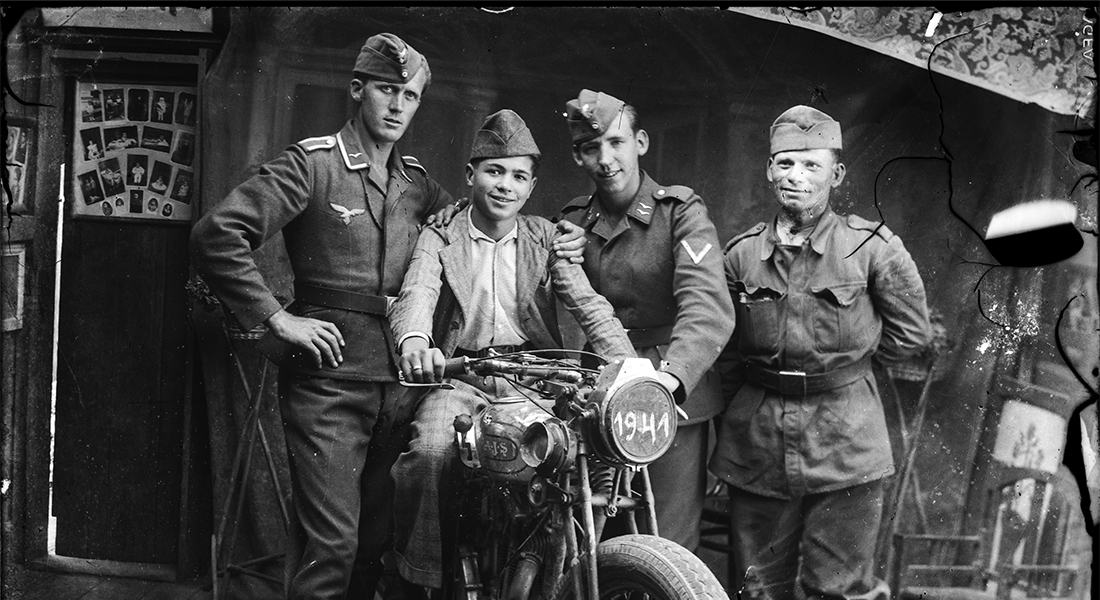A satire of the global pandemic that we still live in. This film begins with a sex tape that goes awry. At stake is the life and career of Emi, a teacher who is forced by her students’ parents to resign. However, Emi refuses. Recommended for those who enjoy transgressive cinematic experiences – in the best sense.

”
The starting point of Uppercase Print is the true story of some graffities that appeared in 1981, in the wall of the Communist Party headquarters, in the city of Botoșani. There was a subsequent investigation to find the author of these subversive messages towards the regime of Ceaușescu. Based on a play by Gianina Cărbunariu about this case, but also archive videos, Jude questions the moulding of individuals in dictatorship times.
—
In a large number of films that followed one another, but are not alike, Radu Jude builds one of the most harrowing and exciting oeuvres in contemporary Romanian cinema. However, what does the picaresque farce Aferim! has in common with the literary surrealism of Scarred Hearts and the historical staging in the game of mirrors I Do Not Care If We Go Down in History as Barbarians? Undoubtedly, more than it seems: first, a discreet but sharp irony and, above all, an uncompromising look at the tacit history of his country – no matter the period and genre of this cinema. There are two types of images in Uppercase Print. First, black and white archival images from the 1980s under Ceausescu. Exciting and frightening images of smiling propaganda, where robotic voices echo dictatorship slogans with fanfare. Other images date from today, in a studio with bright neon lights in vivid colors. Facing the camera, actors recite (more than repeat) the reports written by the communist militias. Disproportionately numerous and detailed descriptions, all related to the same incident: a simple revolutionary slogan written in capital letters (hence the title) by a Romanian high school student in the 1980s. The news is simple, the graffiti author was quickly identified, but the fascist administrative machine’s approach is terrifying because it is relentless by the force of repetition. The investigation is endless, like a gigantic monster that cannot be killed. Uppercase Print alternates between these two families of images, between these two nervous tales with cold monotone voices that give us the shivers: the anecdotal and the national, the hidden history and the propaganda, the superficial smile and the madness behind the scenes of yesterday and today. (Mickael Gaspar)
“
Radu Jude directs a provocative, didactic, inventive and highly intelligent investigation into Romania’s participation in the ethnic cleansing of the Third Reich during the 1941 Odessa massacre on the Eastern Front.
Tara Moarta is built upon what a huge collection of recently discovered Costică Acsinte’s photographs from the 1930’s and 40’s (and a jewish doctor’s journal from the same time) reveal about Romania and what they do not show.
Very early in the morning, Marian, a 7 years old boy from a small and poor Romanian village, wakes up his father and persuades him to go to the city, in order to fix their old TV set.
Inspired by Romanian author Max Blecher’s eponymous novel, it centers on Emanuel, a man in his early 20s, who spends his days at a sanatorium on the Black Sea coast, where he falls in love with another patient.
Radu Jude is one of the highlights of Romania’s new wave. In 2007, “The Tube with a Hat” was one of the most prized short-films of the year (including Best Short-Film in Indielisboa), followed by 4 short-films and 2 feature films: “The Happiest Girl in the World” (2009) and “Everybody in Our Family” (2012), both shown in Indielisboa’s International Competition and 2014 retrospective of Romanian cinema. “Aferim!” takes us through Romania’s feudal lands in the 19th century.)
Tavi, a man in his late thirties, discovers that Alexandra, his 4 years old daughter, is not calling him Dad anymore.
In a fourteenth century building, Trissakia 3 shows us the passing of time as the sunlight moves during the day and illuminates the past, directly or reflected, pointing the future.
When working class teenager Delia wins a luxury car in a promotional campaign, she and her parents travel to Bucharest to shoot a commercial in which she must thank the sponsoring company for the car. As the shoot wears on, the car slowly becomes both the object and catalyst of an absurd clash of desire, values, and will between Delia’s cash-strapped parents and her youthful self.
The family doesn’t need stories, it only needs to be observed, as Radu Jude, filmmaker long linked to IndieLisboa, does in exemplary way in this 2nd feature film. What could be the beginning of a happy holiday becomes a nightmare for this father who just wants to spend time with his daughter, from whom he lives separate due to the divorce. The spiral of violence that the film proposes is consciously used by the director through the choice of close shots and hand-held camera, creating a huis clos to which the viewer feels as trapped as the character. And if you think that movies are only there for extraordinary storytelling, look inside. Then watch your backyard. (Miguel Valverde)









